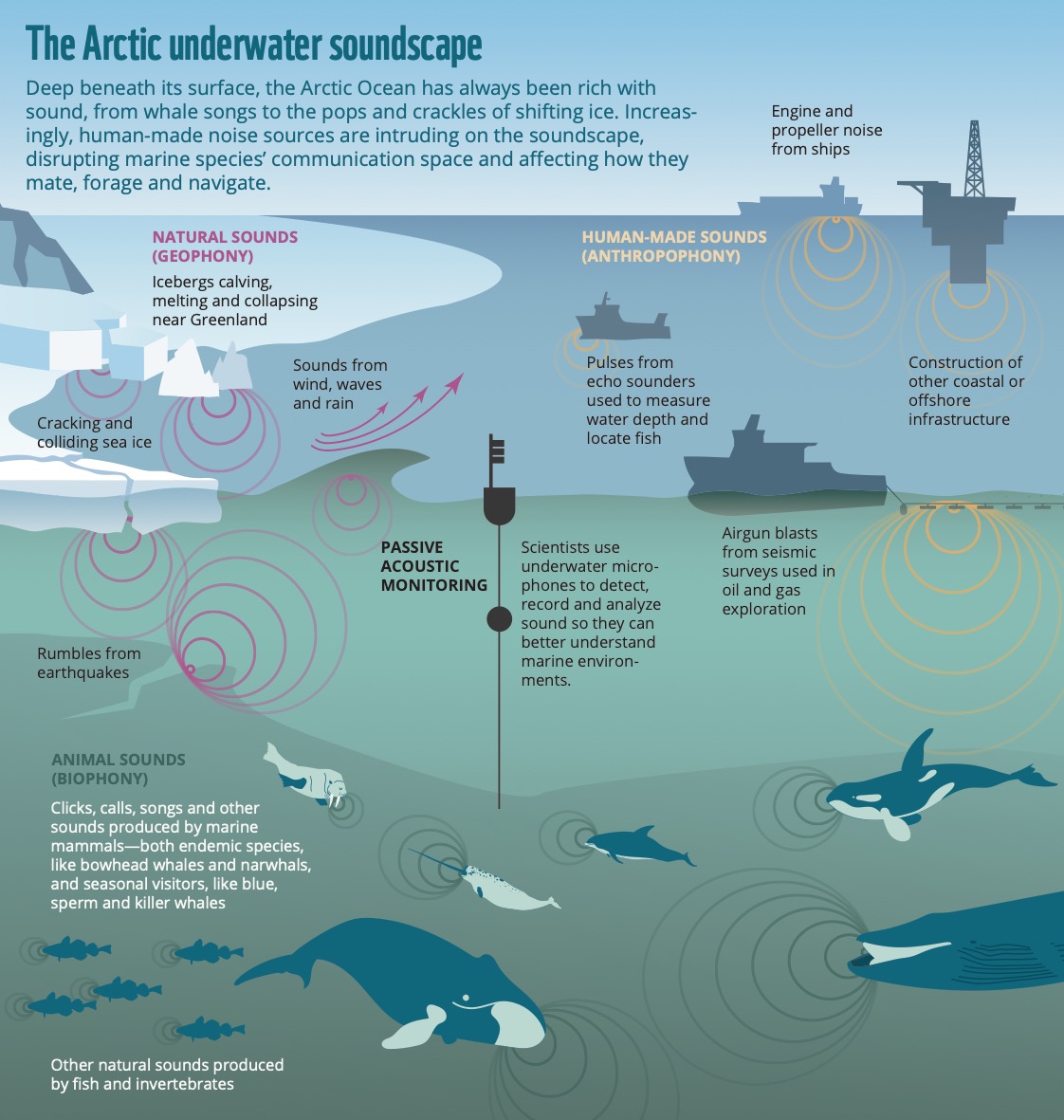© Uwanson Chan / Unsplash
Cold sounds
Eavesdropping on the Arctic Ocean
In the Arctic Ocean, underwater sounds contain important clues for scientists who study marine mammals and the acoustic environment (soundscape) they live in. As KAROLIN THOMISCH and RAMONA MATTMÜLLER write, passive acoustic monitoring (PAM) is a non-invasive, cost-effective technique that provides critical data to support ecological research, conservation and informed policymaking.
At a glance, the Arctic Ocean might seem like a quiet place. Vast, slow-moving sheets of ice stretch out to the horizon. Through a narrow opening in the ice, the occasional rise of a whale’s blow is followed by a grey back. The sun disappears for months, blanketing the area in darkness. But beneath this scenery, the Arctic Ocean is alive with sound. The deep rumbles of shifting ice, high-pitched clicks of narwhals, and mournful songs of bowhead whales produce an invisible symphony. Other sources of sound—such as from human activity or wind-created waves—also contribute to an area’s soundscape.
Studying marine life—and marine mammals in particular—in remote areas like the Arctic Ocean can be challenging. Because these mammals spend substantial parts of their lives underwater, it is hard to study them through visual observation, such as from ships. In addition, Arctic-endemic species, like bowhead whales or narwhals, often inhabit areas that are seasonally inaccessible to researchers, covered by sea ice much of the year.
Passive acoustic monitoring (PAM) has emerged as a crucial tool for studying and understanding marine environments, particularly in challenging regions like the Arctic Ocean.
—Karolin Thomisch & Ramona Mattmüller, marine ecologists, Alfred Wegener Institute Helmholtz Centre for Polar and Marine Research
Passive acoustic monitoring
So how do we study this remote, unseen world? The answer lies in an unexpected approach: by listening.
For many marine mammals, sound is an integral part of life. Many species produce sound in various behavioural contexts—such as when communicating, mating, foraging and navigating. These vocalizations are often distinctive, and can yield information not only about individual species, but even about specific populations.
Passive acoustic monitoring (PAM) has emerged as a crucial tool for studying and understanding marine environments, particularly in challenging regions like the Arctic Ocean. This non-invasive method relies on underwater microphones, known as hydrophones, to record, analyze and detect sound in the ocean. Unlike active sonar, which emits sound waves, PAM listens silently, creating no disturbance. This makes it ideal for long-term observation.
PAM is also uniquely suited to the Arctic environment because of its resilience. Instruments used in the Arctic must be able to withstand extreme cold, ice and pressure, and they need to operate autonomously because there is limited access for maintenance. Fortunately, technological advances have enabled the development of robust, durable recording units capable of collecting data for months or even years at a time.
Finally, sound travels great distances in the ocean—up to hundreds of kilometres, for some species. This makes PAM a highly suited tool for studying resident and migrating marine mammals in remote areas of the Arctic Ocean. Researchers can use it to track seasonal migrations, population trends and behavioural changes.

© WWF Global Arctic Programme
Building a holistic soundscape picture
But PAM also plays a vital role in assessing human-generated noise and its impact on the Arctic ecosystem. As sea ice continues to decline, previously inaccessible areas are opening up to increased human activity, including shipping, oil and gas exploration, and commercial fishing. These developments contribute to increasing noise pollution in the ocean, potentially affecting the behaviours and well-being of marine life. By using PAM to record and analyze noise levels, researchers can assess the spatial and temporal extent of human-generated noise and work toward mitigating its impact through policy and regulation.
The Arctic is warming four times faster than the rest of the globe. The consequences of increasing temperatures and declining sea ice for marine mammals are far-reaching: northward shifts of their distribution ranges, habitat loss due to receding sea ice, growing competition for food, and pressures from predation as species (and more humans) move further into the Arctic Ocean, drawn by the warmer temperatures.
Given the pressing need to monitor the effects of climate change in this vulnerable ecosystem and the challenges presented by the vastness of the region—and the transboundary nature of many marine species—international collaboration and coordination of PAM efforts in the Arctic Ocean is critical. By using signal processing and machine learning techniques to analyze long-term PAM recordings and assess trends in sound patterns (including biological, natural and human sound sources), we can build a clear, holistic picture of the Arctic Ocean soundscape—and ultimately, contribute to scientific knowledge and conservation strategies.
By Karolin Thomisch
Marine ecologist, Alfred Wegener Institute Helmholtz Centre for Polar and Marine Research
KAROLIN THOMISCH IS a marine ecologist who uses passive acoustic monitoring to study marine mammals in the polar oceans. She works at the Alfred Wegener Institute Helmholtz Centre for Polar and Marine Research.
By Ramona Mattmüller
Marine ecologist, Alfred Wegener Institute Helmholtz Centre for Polar and Marine Research
RAMONA MATTMÜLLER IS a marine ecologist who studies polar ocean soundscapes using passive acoustic monitoring. She works at the Alfred Wegener Institute Helmholtz Centre for Polar and Marine Research.